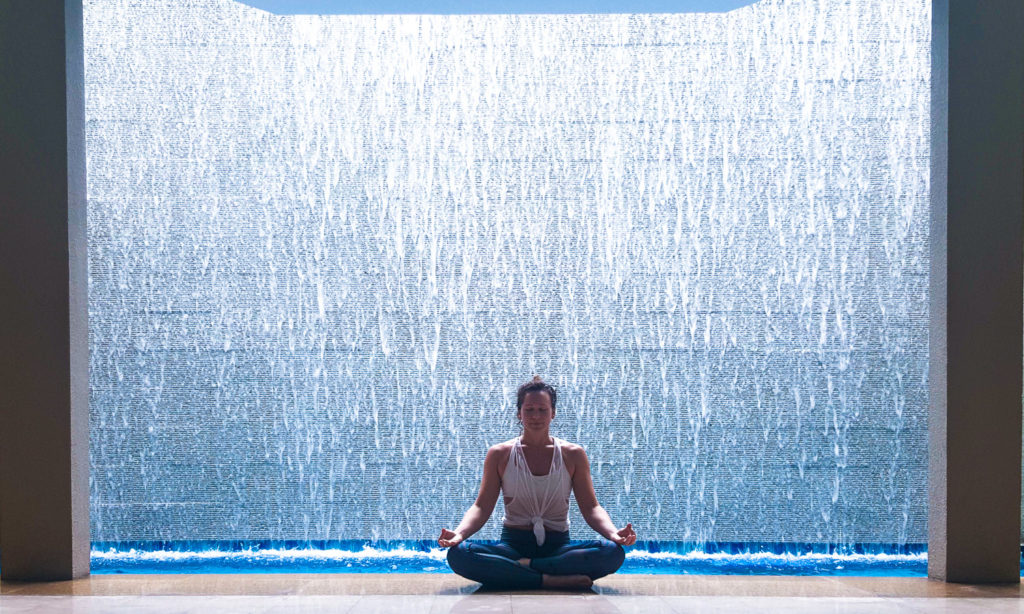Yoga for beginners can be challenging with complex instructions — foot goes here, knee goes here, pelvis… what?
One of the most important things I teach my students is how to breathe. In yoga, awareness of your breath, ‘pranayama’, is derived from two Sanskrit words: prana (life force) and yama (control).
Indeed, we breathe every day and without ever thinking about it! (How fantastic is that?) To achieve optimal performance in ANY sport, it requires control of your breath. So let’s stop and give your breath a little appreciation.
HOW TO DO IT?
Lie down face up along your mat with legs straight. Place your hands on your belly and close your eyes. The first step is awareness of your breath. Start to breathe. Notice the amount of time it takes to breathe. How long is each inhalation and exhalation? Are you breathing through the nose or the mouth?
Start to breathe only through the nose. (unless you have a cold or other impediment) Notice the flow of air as you breathe in? Does your chest or belly rise? Start to feel your belly expand with each inhalation. Think about your breath dropping down into the abdomen, and stay with that image. Work on taking longer and deeper breaths with each cycle. Repeat for as long as you like.
Now, take a scan throughout your body, notice if you are feeling different from when you started. You may notice a calming sensation, feel more relaxed and present in your body — if your mind did not drift to your thoughts, anticipations or worries.
Thanks to today’s busy lifestyle and frenetic pace, we don’t take a lot of time to be present. Thus, when you stop to focus on the breath it takes you out of your mind and into the present moment.
Being more present has many benefits- not to mention stress release, you will be a better listener, gain more clarity, have greater appreciation for the small things and less overthinking.
MORE ABOUT YOUR BREATH.
When people don’t breathe well, they tend to “breathe backwards” (hunching our shoulders and sucking our stomachs in when we take a deep breath). Improper breathing and society’s ‘need’ to have flat bellies so we ‘suck it in’ promotes shallow breathing leading to anxiety, stress, amongst a slew of other problems with your digestive system.
In an article from NPR – Just Breathe, Your Body Has A Built In Stress Reliever, Esther Sternberg a physician, author of several books on stress and healing, and researcher at the National Institute of Mental Health, says, rapid breathing is controlled by the sympathetic nervous system. It’s part of the “fight or flight” response — which is activated by stress.
In contrast, slow, deep breathing actually stimulates the opposing parasympathetic reaction — the one that calms us down.
Yoga brings awareness to your breath — and this is one of your best tools for being present.
In her book, Yoga Mind, Body & Spirit, Donna Farhi, puts it eloquently – ‘The oscillation of breathing is a perfect mirror of the fluctuations of life. Life is like a swinging pendulum, some changes bringing with them difficulties and pain and other changes bringing with them east and joy. If we are open to this process, life will move us.’
By controlling the breath, you can influence your body, mind and every aspect of your life.
Baron Baptiste says, “The breath is the key to unlocking your body’s potential.” Clearing space and letting go of what you must, moving out any stagnant energy on the exhale, and creating space for something new on the inhale.
With practice and commitment to breathe on the mat, you will move with more ease and fluidity. You’ll be able to notice when your breathing is erratic, or shallow or perhaps when you are unintentionally holding your breath.
As you become more aware and curious of your breath, you also may begin to notice the correlation of your breath quality with your mood or state of mind. Control of your breath can help shift your patterns and, through regular practice, create positive change in your life.
Presence and increased awareness of breathing can impact positively on our health, confidence and stress levels.
Coming soon part 2 of the breath blog with techniques you can try at home.

